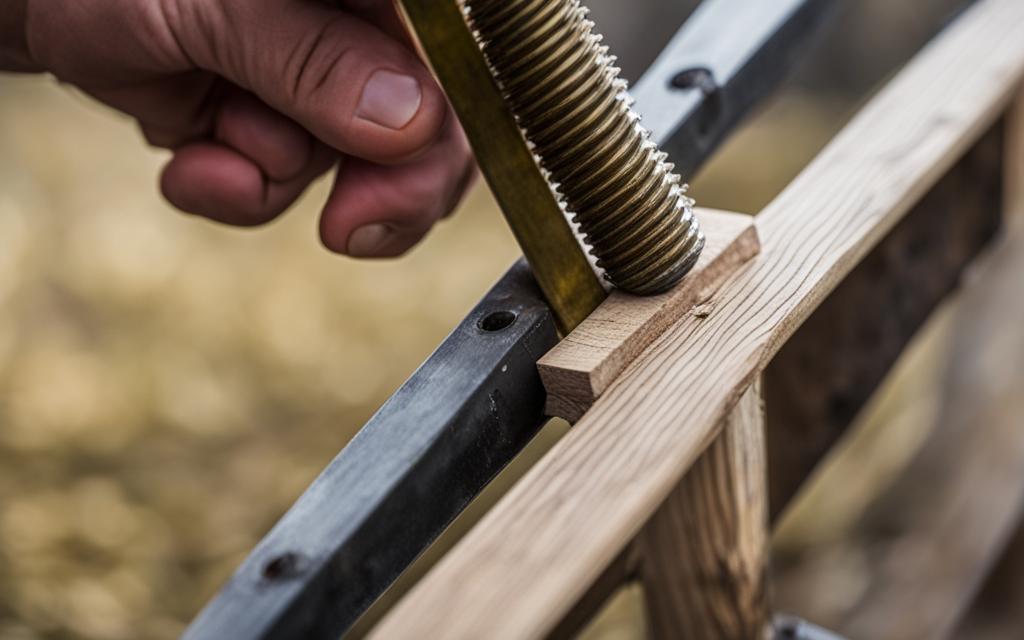Ensuring the safety and integrity of structures in the construction industry is of paramount importance.
Bolt safety standards play a crucial role in this regard, establishing guidelines for the design, installation, and maintenance of bolts.
By adhering to these standards, the risk of structural failures and accidents can be significantly reduced.
Timber bolts, in particular, are specialized fasteners widely used in timber construction applications.
With their high tensile strength and resistance to corrosion, these bolts provide a secure and durable connection between wooden elements, making them suitable for outdoor and exposed environments.
Bolt safety standards vary across different countries and regions.
Each jurisdiction may have its own set of regulations, codes, and standards governing the design, installation, and inspection of bolts.
Examples include the American Society of Mechanical Engineers (ASME) standards in the United States, the European EN1591 standard, and standards set by various industry organizations.
When it comes to bolts, proper safety measures should be followed during installation and maintenance.
Regular inspections for signs of degradation, adherence to recommended torque values, and routine maintenance are crucial for ensuring the integrity of the structures and the bolts that support them.
Key Takeaways:
- Bolt safety standards are vital for ensuring the safety and integrity of structures in the construction industry.
- Standards for bolt safety vary across different countries and regions, with each having its own regulations and codes.
- Proper safety measures should be followed during the installation and maintenance of bolts to ensure their reliability.
The Importance Of Bolt Safety Standards
Bolt safety standards are of paramount importance in the construction industry.
These standards provide a set of guidelines and regulations that ensure the safety and integrity of structures.
By establishing strict protocols for the design, installation, and maintenance of bolts, these standards help reduce the risk of structural failures and accidents.
Adhering to bolt safety standards is crucial for the construction industry as it helps maintain a high level of safety for workers, occupants, and the general public.
The proper implementation of these standards ensures that bolts are designed and installed correctly, minimizing the potential for structural problems and maintaining the overall stability of buildings, bridges, and other infrastructure.
Furthermore, bolt safety standards promote consistency and accountability within the construction industry.
By setting clear guidelines, they ensure that all stakeholders follow best practices and adhere to established safety protocols.
This, in turn, fosters a culture of safety and professionalism, enhancing the reputation of the industry and instilling confidence in clients and investors.
Building codes and regulations often incorporate bolt safety standards, making compliance mandatory in many jurisdictions.
Failure to comply with these standards can result in legal and financial consequences for construction companies and individuals.
Therefore, staying up-to-date with the latest bolt safety standards is essential for both legal compliance and the overall success of construction projects.
“Bolt safety standards play a critical role in safeguarding lives and property in the construction industry. Following these standards is not only a legal obligation but also a moral responsibility towards ensuring the safety and well-being of workers and the public.”
Implementing and enforcing bolt safety standards is a shared responsibility among construction professionals, engineers, architects, regulatory bodies, and industry organizations.
By working together and prioritizing safety, the construction industry can create a safer environment for everyone involved.
Bolt Safety Standards Worldwide
Bolt safety standards play a crucial role in ensuring the safety and integrity of structures around the world.
However, it’s important to note that these standards can vary across different countries and regions.
Each country or region may have its own set of regulations, codes, and standards governing the design, installation, and inspection of bolts.
Examples of such standards include the American Society of Mechanical Engineers (ASME) standards in the United States, the European EN1591 standard, and standards set by various industry organizations.
These standards outline the requirements and guidelines for bolted connections in different construction applications, helping to prevent structural failures and accidents.
“The implementation of bolt safety standards is essential for ensuring the safety of construction projects worldwide.”
Having uniform bolt safety standards worldwide is crucial for maintaining consistency and ensuring the safety of bolted connections in construction projects across borders.
It allows for better collaboration and easier sharing of knowledge and best practices among professionals in the construction industry.
Moreover, these standards provide a basis for quality control and conformity assessment of bolts used in various industries.
By adhering to these standards, manufacturers can ensure that their bolts meet specific requirements, thereby enhancing the reliability and safety of the products.
The Role Of Worldwide Regulations And Codes
Regulations and codes are integral components of bolt safety standards worldwide.
They provide a framework for ensuring compliance and maintaining consistent safety practices.
These regulations and codes often incorporate the requirements of international standards organizations, such as the International Organization for Standardization (ISO) and the International Electrotechnical Commission (IEC).
Furthermore, worldwide regulations and codes consider various factors such as load capacity, corrosion resistance, installation techniques, and maintenance procedures to ensure the long-term safety and performance of bolted connections.
They aim to mitigate risks associated with design flaws, material deficiencies, improper installation, and inadequate maintenance.
The Benefits Of Harmonized Bolt Safety Standards
Harmonized bolt safety standards bring numerous benefits to the construction industry worldwide. They:
- Promote consistent safety practices across borders
- Enhance collaboration and knowledge sharing among professionals
- Improve the reliability and safety of bolted connections
- Streamline quality control and conformity assessment processes
- Facilitate the global exchange of construction materials and equipment
- Increase confidence in the construction industry
By embracing standardized bolt safety practices on a global scale, the construction industry can ensure safer and more reliable structures, ultimately benefiting both professionals and end-users alike.
Safety Measures For Bolts
When it comes to bolts, following safety measures is crucial during installation and maintenance.
These measures ensure the integrity of the bolts and the structures they support.
Proper inspection of bolts is essential to identify any signs of degradation or damage that may compromise their strength and performance.
During installation, it is important to adhere to recommended torque values to achieve the desired clamping force and prevent over-tightening or under-tightening the bolts.
This helps maintain the structural integrity of the timber connections and reduces the risk of bolt failure.
Regular maintenance is necessary to preserve the longevity of bolts.
This involves periodic inspections to check for any loosening, corrosion, or wear on the bolts.
Any identified issues should be promptly addressed to ensure the continued safety and stability of the structures.

“Following safety measures during the installation and maintenance of bolts is crucial to ensure the structural integrity and stability of any connections.”
Comparative Analysis Of Bolt Safety Standards
Conducting a comparative analysis of bolt safety standards is crucial in ensuring the integrity and safety of bolted connections in construction projects worldwide.
This analysis allows for the evaluation of similarities, differences, strengths, and weaknesses among various standards, promoting best practices and identifying areas for improvement.
By comparing and contrasting these standards, industry professionals can enhance safety measures and mitigate potential risks associated with bolted connections.
Bolt safety standards vary from country to country, with different regulations and codes governing the design, installation, and inspection of bolts.
For instance, the United States follows the standards set by the American Society of Mechanical Engineers (ASME), while Europe adheres to the European EN1591 standard.
Additionally, numerous industry organizations contribute their own set of standards to ensure bolt safety and compliance.
“A comparative analysis allows us to understand the strengths and weaknesses of different bolt safety standards, leading to improved safety practices in the construction industry,”
Through comparative analysis, it becomes evident that worldwide regulations reflect regional considerations and requirements.
This analysis provides valuable insights into the effectiveness of safety measures and the need for alignment or harmonization of standards to enhance cross-border cooperation and safety standards compliance.
It is worth noting that the comparative analysis of bolt safety standards is not only beneficial for regulatory bodies and industry professionals but also for manufacturers, suppliers, and end-users.
Understanding and adhering to these standards ensure the accuracy and reliability of bolted connections in various construction applications.
The Role Of Comparative Analysis
Comparative analysis plays a vital role in identifying the strengths and weaknesses of bolt safety standards worldwide.
By examining different countries’ approaches, best practices can be adopted universally, minimizing risks and improving safety.
Additionally, it facilitates knowledge sharing and collaboration among global stakeholders, leading to advancements in bolt safety technologies and practices.
By conducting comparative analysis, the construction industry can work towards achieving uniformity in bolt safety standards, ultimately enhancing overall safety in construction projects across the globe.
The continuous evaluation and improvement of these standards contribute to the development of innovative solutions and the prevention of accidents and structural failures.
Challenges In Implementing Bolt Safety Standards
The implementation of bolt safety standards in the construction industry can pose several challenges.
These challenges arise from various factors that impact the adoption and adherence to these standards.
Overcoming these challenges is crucial to ensure the safety and integrity of bolted connections.
Lack Of Awareness And Understanding
One of the major challenges in implementing bolt safety standards is the lack of awareness and understanding among stakeholders in the construction industry.
Many professionals may not be well-informed about the specific requirements and guidelines outlined in these standards.
This lack of awareness can lead to inconsistencies in the application of safety measures and compromise the overall safety of bolted connections.
Resistance To Change
Implementing new safety standards often requires changes in established practices and procedures.
This can be met with resistance from industry professionals who are comfortable with existing methods.
Overcoming this resistance requires effective communication, education, and showcasing the benefits of complying with updated safety standards.
Creating a culture that values safety and encourages continuous improvement is essential to address this challenge.
Inadequate Training And Education
Another challenge is the inadequate training and education provided to professionals involved in the design, installation, and maintenance of bolted connections.
Insufficient knowledge of best practices, proper techniques, and the latest industry developments can hinder the effective implementation of safety standards.
Investing in comprehensive training programs and promoting ongoing professional development can help address this challenge and improve the competence of industry practitioners.
Continuous Updates And Evolving Technologies
Bolt safety standards need to evolve continuously to keep pace with advancements in technology, materials, and construction practices.
Implementing these updates can be challenging for industry professionals who must stay informed about the latest revisions to the standards and adapt their processes accordingly.
Regularly updating training programs, providing access to comprehensive resources, and fostering collaboration between industry stakeholders can help address this challenge.

In summary, the implementation of bolt safety standards in the construction industry faces various challenges, including lack of awareness and understanding, resistance to change, inadequate training and education, and the need for continuous updates.
Overcoming these challenges requires proactive measures, such as increasing awareness, providing comprehensive education and training, and fostering a culture of safety and continuous improvement.
By addressing these challenges, the construction industry can enhance the safety and reliability of bolted connections, ultimately safeguarding lives and ensuring the structural integrity of buildings and infrastructure.
Advancements In Bolt Safety Technologies
The construction industry is constantly evolving, and with it, advancements in bolt safety technologies are being made to ensure the highest standards of safety and performance.
These advancements have revolutionized the way bolted connections are designed, installed, and maintained, making them more secure and reliable than ever before.
One key area of advancement is in bolt materials.
Engineers and manufacturers are developing innovative materials that offer enhanced strength, durability, and corrosion resistance.
These materials include high-strength steel alloys, composites, and coatings that provide increased longevity and structural integrity.
Testing methods have also seen significant improvements.
Advanced non-destructive testing techniques, such as ultrasound and laser technology, allow for thorough inspections of bolts without causing any damage.
These methods can detect microscopic flaws and defects that may compromise the strength and safety of the bolts, enabling timely repairs or replacements.
The introduction of state-of-the-art inspection techniques has revolutionized bolt safety.
Automated inspection systems equipped with advanced imaging and sensing technologies can quickly and accurately assess the condition of bolts, identifying any signs of wear, corrosion, or fatigue.
This proactive approach to inspection allows for early detection and mitigation of potential issues, minimizing the risk of failures.
“Advancements in bolt safety technologies have improved the overall safety and performance of bolted connections in the construction industry.”
Another significant advancement is the development of advanced monitoring systems.
These systems utilize sensors and data analysis technologies to continuously monitor the performance and behavior of bolted connections in real-time.
By collecting and analyzing data on factors such as bolt tension, temperature, and vibrations, these monitoring systems can provide early warnings of potential issues, allowing for timely interventions.
The integration of these advancements in bolt safety technologies has led to increased confidence in the performance and reliability of bolted connections in the construction industry.
Builders, engineers, and project managers can now make informed decisions based on accurate data and leverage the technological advancements to enhance the safety and efficiency of their projects.
Overall, the advancements in bolt safety technologies have had a profound impact on the construction industry, setting higher standards for safety, reliability, and longevity.
As technology continues to advance, it is crucial for industry professionals to stay updated with the latest developments and incorporate these advancements into their practices, ensuring the ongoing improvement of bolt safety standards.
Future Directions In Bolt Safety Standards
As the construction industry continues to evolve, the future directions of bolt safety standards are critical to ensuring the ongoing safety of structures.
These directions encompass various aspects, including the incorporation of new technologies, the integration of sustainability practices, enhanced collaboration among stakeholders, and the application of lessons learned from real-world incidents to drive continuous improvement in bolt safety.
Embracing New Technologies
The ever-advancing field of technology offers numerous opportunities to enhance bolt safety standards.
For example, the implementation of advanced sensor technology can enable real-time monitoring of bolted connections, ensuring timely identification of potential issues.
Additionally, the utilization of artificial intelligence and machine learning algorithms can improve the accuracy of bolt integrity assessments, reducing the risk of failures and accidents.
Integrating Sustainability Practices
The construction industry is increasingly focused on sustainable practices, and bolt safety standards should align with these principles.
Manufacturers can explore environmentally friendly materials and coatings for bolts, reducing their impact on the environment without compromising safety.
Furthermore, the development of sustainable manufacturing processes can help minimize resource consumption and waste generation.
Enhanced Collaboration Among Stakeholders
A collaborative approach involving all stakeholders is crucial for the development and implementation of effective bolt safety standards.
Construction professionals, engineers, manufacturers, and regulatory bodies should engage in continual dialogue to share knowledge, exchange best practices, and collectively address emerging challenges.
This collaboration can lead to the establishment of unified global standards and the harmonization of regulations, further enhancing the safety of bolted connections across the industry.
Incorporating Lessons Learned
Real-world incidents provide valuable opportunities for learning and improvement in bolt safety standards.
By carefully analyzing the causes of accidents and failures, industry experts can identify vulnerabilities and develop measures to mitigate risks.
Lessons learned from such incidents can inform the development of updated regulations, codes, and guidelines that address the specific challenges faced by the construction industry.
Ultimately, by embracing new technologies, integrating sustainability practices, enhancing collaboration among stakeholders, and incorporating lessons learned, the future directions of bolt safety standards will drive continuous improvement in the construction industry.
These advancements will not only enhance the safety and reliability of bolted connections but also contribute to the overall progress and sustainability of the industry as a whole.

The comparative study of bolt safety standards worldwide highlights the significance of implementing and adhering to these standards to ensure the safety of bolted connections in the construction industry.
The safety measures for bolts play a particularly crucial role in maintaining the integrity of all structures.
Continuous improvements and advancements in bolt safety standards are essential for promoting safer construction practices and mitigating the risks associated with bolted connections.
It is important for the construction industry to stay updated with evolving technologies and practices, integrate sustainability measures, and enhance collaboration among stakeholders to drive continuous improvement in bolt safety.

